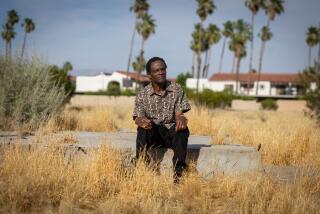Internees Make Pilgrimage to Desert : Utah: Nearly 400 Japanese-Americans trekked to the site--many for the first time since their imprisonment by the U.S. government during World War II.
- Share via
DELTA, Utah — Half a century ago, hundreds of Japanese-Americans were relocated from the West Coast to a ramshackle camp in the central Utah desert, as close to the middle of nowhere as can be found.
Today, few travelers take the dusty two-lane road a dozen miles west of Delta to the remnants of the camp, named Topaz after a nearby mountain. The most frequent guest is the wind, which seemingly never stops blowing.
But one recent Sunday, nearly 400 former internees trooped out of buses and stood squinting in the sunlight. Many were returning for the first time since their imprisonment by the U.S. government during World War II.
“We were singing songs on the bus on the way out here, but not even the air-conditioning could keep the dust out,” said Florence Uyeda Miyahara, one of nine sisters revisiting the camp. “The singing stopped when we got close.”
In the hysteria after Japan’s surprise attack on Pearl Harbor in 1941, President Franklin D. Roosevelt ordered the relocation of 110,000 Japanese and Japanese-Americans living on the West Coast.
The justification was security, although there was no evidence of disloyalty in the Asian community.
Tent camps were constructed. Behind barbed-wire and guard towers, Topaz held 8,300 people, making it Utah’s fifth-largest city at the time.
Miyahara, 69, a retired Denver pediatrician, said her family was ordered to Topaz from their San Francisco home in 1942.
Out of unforgiving surroundings, with summer temperatures soaring into the 100s and spells of subzero weather in the winter, residents scraped together a community. They nursed vegetables, and when crops would not hold in the hardscrabble, fashioned elaborate rock gardens.
The wind would sometimes whip the ubiquitous powdery dust into choking storms that would darken the sky, Miyahara recalled.
“We’d have these incredible sunsets,” she said. “There were some pretty times in the camp. But not many of them.”
All that marks the camp now is a granite monument, the concrete pads on which the 500 tar paper barracks sat, and shards of glass and rusted pipes of potbellied stoves.
The hospital and high school long ago were torn down by scavengers.
Tomoye N. Takahashi and her husband, Henri, came back to Topaz with their daughter, who was born in the camp.
At a dinner reception in Salt Lake City, the ex-internees recited the Pledge of Allegiance--an irony not lost on Tomoye Takahashi, who lives in San Francisco.
“Every night in the camps, we used to stand there behind fences and sing ‘God Bless America’ as they lowered the flag,” she said. “They would ask us if we were loyal, and we would say yes. And we would mean it.”
Her daughter, an artist who calls herself Masako, said she was ambivalent about making the trip to the camp. “It’s difficult to believe it happened, but it’s also difficult to ignore the town name on your birth certificate,” she said.
Daisy Uyeda Satoda, 65, stood looking over the place where she lived as a teen-ager.
“The emotion really hasn’t hit me yet,” she said. Then she stopped, put her hands to her mouth.
“I can’t believe I actually lived here,” she said, choking back tears and waving at the sun-blasted desert. “There’s nothing.”
More to Read
Sign up for Essential California
The most important California stories and recommendations in your inbox every morning.
You may occasionally receive promotional content from the Los Angeles Times.










